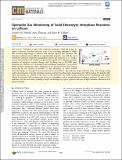Operando Gas Monitoring of Solid Electrolyte Interphase Reactions on Lithium
Author(s)
Hobold, Gustavo M.; Khurram, Aliza
DownloadPublished version (2.629Mb)
Publisher with Creative Commons License
Publisher with Creative Commons License
Creative Commons Attribution
Terms of use
Metadata
Show full item recordAbstract
Formation of stable solid electrolyte interphases (SEI) that protect Li against continuous electrolyte reduction is one of the remaining challenges to enable safe, secondary high-energy Li batteries with minimal capacity loss. However, SEI formation pathways remain difficult to experimentally pinpoint, even with the most well-known carbonate electrolytes and graphite anodes, and especially on Li. Using a custom electrochemical cell coupled to a gas chromatograph (GC), dynamic gas-phase signatures of interphase reactions during a first Li plating step in EC/DMC were monitored as a function of cell chemistry and operational parameters. The operando nature of these experiments allows distinction to be drawn between gases formed chemically by the reaction of metallic Li and electrolyte, vs those evolved electrochemically, i.e., through electron-transfer and reaction with Li+. Quantification of gas evolution molar ratios during cycling enables determination of specific interphase reactions and their branching ratios dominating active SEI formation. We find that SEI-repair mechanisms are sensitive to the choice of the electrolyte salt (LiPF6/LiClO4/LiTFSI), solvent fluorination, and current density. In particular, SEIs resulting from solvent decarbonylation and/or decarboxylation - leading to enhanced CO and/or CO2 evolution - are the most stable, providing a simple and descriptive gas-phase signature indicative of high Coulombic efficiencies of Li plating/stripping.
Date issued
2020-02Department
Massachusetts Institute of Technology. Department of Mechanical EngineeringJournal
Chemistry of Materials
Publisher
American Chemical Society (ACS)
Citation
Hobold, Gustavo M., Aliza Khurram and Betar M. Gallant. “Chemistry of Materials” Chemistry of Materials, vol. 32, no. 6, 2020, pp. 2341-2352 © 2020 The Author(s)
Version: Final published version
ISSN
0897-4756